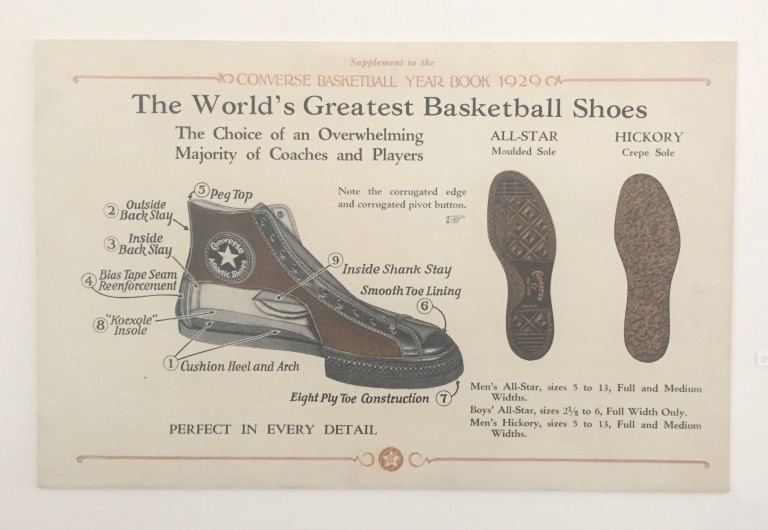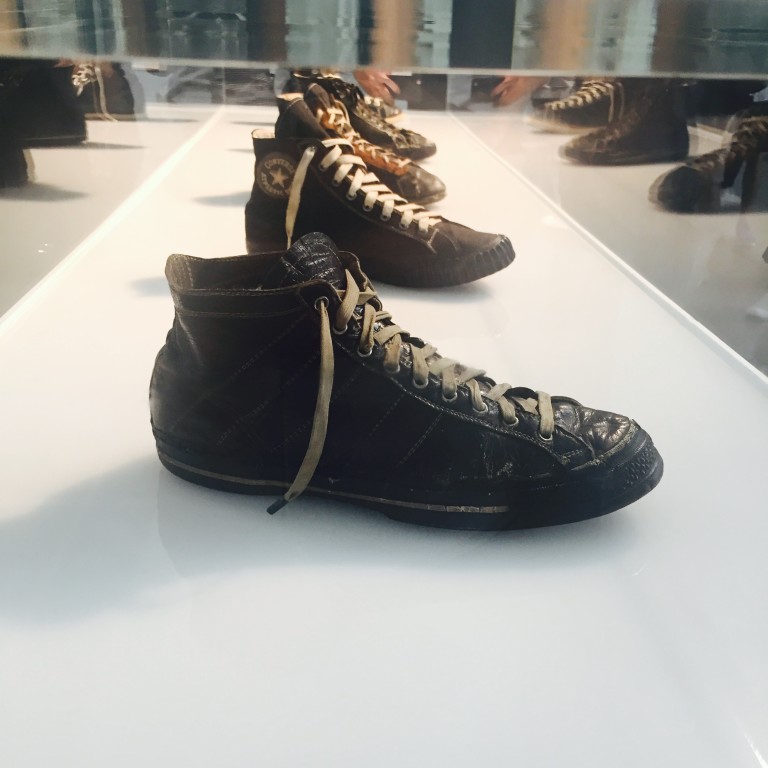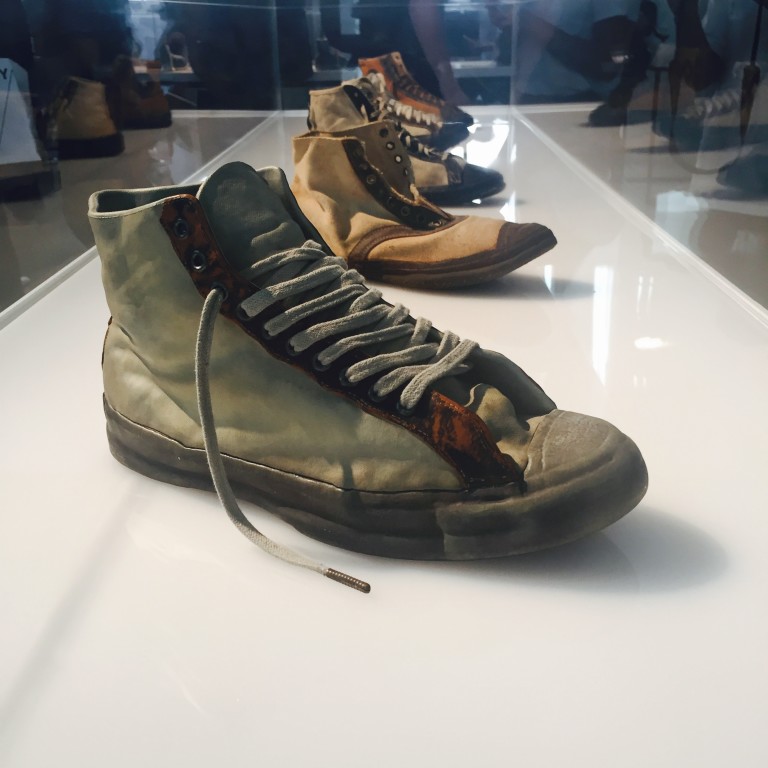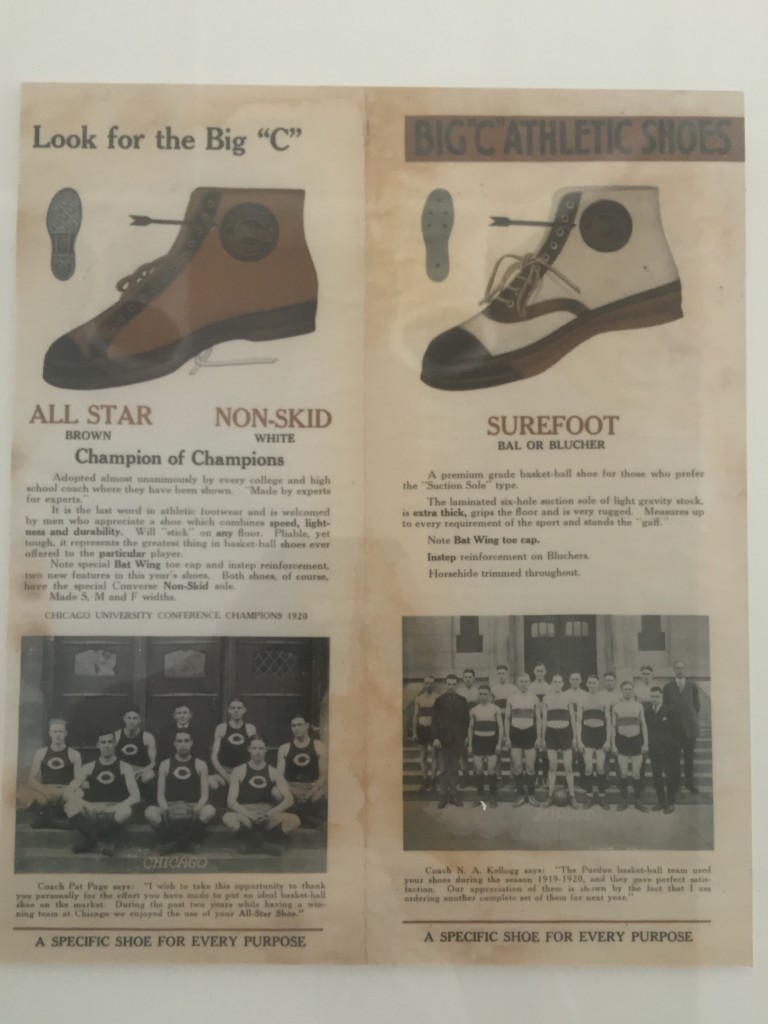A Brief History of the Converse All Star – Reblog via Gwarizm


Footwear obsessive and Fountain of Knowledge Gary Warnett recently sat down to collate a history on everyones favourite canvas basketball icon for art & culture publication 032C. If you’ve got an interest in the Converse brand, ten minutes to spare, and a cup of tea at the ready then it’s well worth reading up on the origins of the All Star and it’s status over the decades.
A few weeks ago I covered the Converse All Star Modern launch for 032c and we had to leave out a fair chunk of historical talk regarding the Converse All Star. Seeing as it’s such an important design (whether you care much for shoes or not), here’s the part of the rough draft that was excised. As always with these kinds of things, I encourage all feedback and corrections. It still blows my mind that this shoe is a century old next year.
Converse’s in-house archivist Sam Smallidge is deeply enthusiastic about the All Star and the brand that made it despite no previous inclination towards athletic footwear. Having previously been an Ernest Hemingway Collection Intern at the John F. Kennedy Presidential Library, trading Papa for Chuck has been a new outlet for his love of discovery for research, “My favourite part of the job is joining the dots — my personality type is getting obsessed with whatever collection I’m working on to obsessive detail.“
Converse’s new headquarters include a substantial archive area with 3,000 square feet of space rather than the previous 1,000. What was kept off-site is now in one location, and Smallidge’s storage system has a science to it, “We keep it at 65-degree relative humidity, 67-degree somewhere in there, about 50-percent relative humidity. Some of this stuff holds up well. I’m very lucky that this can be a durable medium. We reinforce with tissue paper and we use polyester fibre fill to stuff all the shoes, which is non-acidic stuffing element that we could use.”
Contrary to the glossy ads and marketing campaigns of the last few decades, Converse’s footwear history stretches back to 1908 and that necessitates sifting through yellowed pamphlets and digging at a museum level to form a narrative, with the history of Converse paralleling the story of America itself during some particularly testing times.
Based in Malden, Massachusetts, and founded by Marquis Converse, the Converse Rubber Shoe Company, moved into athletic shoe manufacture around 1915. The brand’s tagline of the time reads, “For reglar fellars” and the imagery of the time shows rubber toe capped canvas models aimed at outdoor play.
The All Star began life in 1917 under another name — the Non Skid, with a traction outsole design that’s still visible in a modern All Star’s sole pattern. Smallidge hasn’t located the shoe’s original inventor, “It’s one of those lost things. We have patents for certain elements of it, but again, you have to take it with a grain of salt whether it was perhaps just the person on top getting the credit. Unless I see a smoking gun like a hand printed note that says something like, ‘Today, Billy created the moulded outsole…”


The Non Skid was sold as a sibling of the popular Big Nine — an affordable hiking design that could be the forefather of today’s lightweight hiker — and other late 1920s models for basketball also boasted new innovations, like the red rubber “suction sole” of the Collegiate Bals shoe. Basketball was a new sport at the time, having been created by Dr. James Naismith in 1891, and while Converse weren’t the first to make a shoe solely for the game, they’d use their popularity to become the leading brand for the sport.
A typical Converse shoe formula of the time added some equine ingredients, with a blucher cut complemented by a hardwearing duck canvas, bat wing toecap, leather laces, and horsehide reinforcement. The years might have erased memories of other Converse models like the Dodger, Lite Six and Delevan Outing Shoe, or an entire 1925 line of women’s basketball shoes like the Siren. Ebony and Janet, but their existence was a testament as to how serious the company was in cornering this growing market.
For Smallidge, there’s one key gap in the archive that a quick Google won’t help, “There’s stuff from 1917 and 1919 but we have nothing from 1918. So something might have changed during that time but, frustratingly, we have no idea how.”
1919 editions of the Non Skid already bore familiar details like a diamond pattern and leather ankle patch, and in 1920, its name was changed to the All Star. Adding extra confusion to the narrative, for a short time that renaming only applied to the brown pair, while a white edition retained the Non Skid name. Keen to spread the gospel of the basketball game, Converse’s sales strategy was to extoll the importance of the game as much as their shoes, and from 1922 to 1980, they published a yearbook. With hints, tips, plays and coaching advice, it talked technology too, breaking down what the right footwear was for the sport (naturally, they recommended Converse).


It was around 1922 when a keen basketball player and aspiring salesman called Charles Hollis “Chuck” Taylor joined Converse. At the time, like other rubber and sportswear companies, the Converse Rubber Shoe Co. had its own basketball team, coincidentally called the All-Stars, which Taylor played on. His sales skills picked up and his demonstration games and basketball clinics across the U.S. would help build the All Star’s sales, making him an important promotional weapon for the company rather than the shoe’s inventor, as revisionist history might have it.
With the shoe now called the All Star, advertising from the mid to late 1920s extolls the technology it contained. In our age of performance fabrics, one-piece builds and 3D printing, the notion of playing in canvas and rubber seems absurd and possibly career ending, but at the time, this was cutting-edge. Cushioned heel support was something new in 1925, resounding to the evolution of the game, and a 1929 blow out diagram image of the All Star — which by then, bore the familiar star on the heel patch, boasted taped seam reinforcement, a comfort insole, a cushioned heel and arch, eight ply toe construction, smooth toe lining and shank stay.

All Star variants were available during this decade, like 1922’s Featherweight, which included a cushioned felt sole from its sibling Professional model, the Hickory from around 1927 with a crepe sole and the Featherweight from around 1929 which used a lighter sole compound, reiterating that stripped down weight reducing reworkings aren’t a modern phenomenon.
Just ahead of the Great Depression, the Converse company was sold, before being sold again in 1933. Taylor’s front man status was conferred when his signature was added to the shoe in 1934, though early 1930s advertising materials reiterate, as if to reassure consumers, that no changes had been made to this bestseller. In 1936, basketball was an Olympic medal event for the first time and Converse equipped the U.S. national team with white All Stars with a red and blue pinstripe that became a defining feature — something that’s still on white All Stars.

By the late 1930s, rivals like Keds and B.F. Goodrich’s P.F. Flyers (who would join Converse in 1972, resulting in the acquisition of Goodrich’s Jack Purcell badminton shoe) had hi-tops built for basketball, but the game blossomed in the post-war era and so did Converse. With the inception of the NBA in 1946, the All Star had become synonymous with the league. In 1948, the black leather All Star and white Olympic All Star were joined by the familiar black canvas All Star with a white rubber sole and contrast white stitching. A low-cut edition of the shoe called the All Star Oxford (frequently abbreviated to Ox) debuted in 1957 with insight from the Harlem Globetrotters.
The Globetrotter revelation came relatively recently though an intern digitising old tapes of management interviews. According to Smallidge, “Basically, when the Harlem Globetrotters came to Boston to play an exhibition game, Converse took a box of hi-top shoes with them and basically took scissors to hack them down to create a crude low-top, had them run around in them to get feedback on them, whether they should be higher or lower.”


Another rarity in the archive is a late 1950s hi-top All Star with a blue toecap — a lead lined version for strengthening ankles. After a few decades of innovation in its early days, after 40 years, changes to the design were minimal in subsequent years. The patch was periodically altered and the plate changed occasionally, but the formula was in place.
Basketball made significant changes in the 1960s, with the launch of the ABA (American Basketball Association) in 1967 with its flashier game that would give way to the era of slam-dunking and faster play. German brands like adidas and PUMA had targeted basketball with their leather and suede designs, making canvas and rubber look archaic. It’s a shame that such a comfortable version of the real All Star — the 1970 iteration — was timed for its retirement from the game. Converse launched new leather and suede All Stars (the 1974 suede All Star was rechristened the One Star for its 1990s resurrection) in response, putting the original out to pasture as a fashion shoe, complete with a new set of bold canvas colours.


After Converse was purchased by the Eltra Corporation, the All Star took a number of subcultural adventures. With the 1950s retro boom sparked by movies like 1973’s American Graffiti and ABC TV-show Happy Days creating a possibly anachronistic look and the nascent NYC punk peddled by the Ramones (who, by all accounts were keener on Keds and PF Flyers to start) creating a trend from Brooklyn greaser looks, a new culture wanted the Chuck Taylor. In the UK, the shoe was elusive, meaning that any similar, cheaper boot was a substitute, but Sid Vicious and Joe Strummer (Marky Ramone told Spin that he gifted Strummer in a 2012 article) got hold of some. As a more rebellious skate culture began its ascent in the late 1970s, Duane Peters and Steve Olson embraced the punk look to bring All Stars to pools and ramps. Elsewhere in California, a culture of colour-led gang warfare would turn red or blue Chucks into a mark of allegiance.
In 1979 Converse was sold again. In the 1980s, All Stars were decorated with new print patterns inspired by camouflage, zebras, giraffes and even licensed Batman logos. After Allied struggled to build the company, another company called Interco Inc. purchased the brand in 1986. The company made direct links to skate culture too, endorsing Rodney Mullen and Jason Jessee, while the dawn of grunge in the early 1990s put them on Kurt Cobain’s feet as a contrarian response to the gaudy performance technologies of the time. Midsoles had become flatter and extra stitching on the shoe had been removed.
Converse became independent again in 1994 and a 1996 tribute called the All Star 2000 tried to bring an updated aesthetic back to the court as part of a bid to bring the All Star name back to life beyond lifestyle wear. The futuristic looks of All Star Smooth with its gimmicky “React Juice” liquid technology weren’t alone. NBA bad boy Dennis Rodman’s All Star Rodman shoe incorporated details based on his tattoos and was accompanied by several other designs like the Elevate and Sky Tech. Most were so Nike-like in their flowing lines that they bore no resemblance to the Chuck at all. That was followed by a failed attempt to reboot their skate program with chunky models in 1999 and 2000 for Kenny Anderson that bore All Star branding on their tongues. The end of the U.S. made Chuck in the early 2000s and the Nike, Inc. acquisition of Converse in 2003 would lead to the next era for the shoe.
Another attempt to make the All Star a pro favourite fizzled out again when the All Star Revolution for newly signed NBA MVP Dwayne Wade finally arrived in 2008 as part of a pack timed for the brand’s first century in business made little noise. The All Star name was confined to fashion and skate again.
The CONS CTS was a skate-centric version of the shoe released in 2009 and 2013’s CTAS Pro shoe, with Nike’s Lunarlon cushioning inside, indicated that subtle internal improvements to the shoe were a more commercial prospect. After the early 2014 release of Supreme’s Cherry video, the film’s trendsetting popularity All Star had become the skate shoe of choice again, twinned with hiked up Dickies and a tucked in tee.
A 2013 re-release of the 1970s All Star shape via Converse’s top-tier First String line was a reminder that the shoe still looks better on the foot than any other design and that, unlike the narrow, poorly made excuse for an All Star that had been on sale for the 14 or so years previous, it could be comfortable too. While altering the shape and DNA of the silhouette might be heresy to some, 2015’s Chuck II and last month’s All Star Modern are just continuing the constantly shifting treatment of the shoe since the day it first debuted.
Just as the brand is obliged to push things ahead and its team tries to decipher the complexities of a modern mindset, Smallidge is still adding to the history and occasionally finding amends, “I still find new things. I could be looking through a scrapbook and see a different date for something.”







